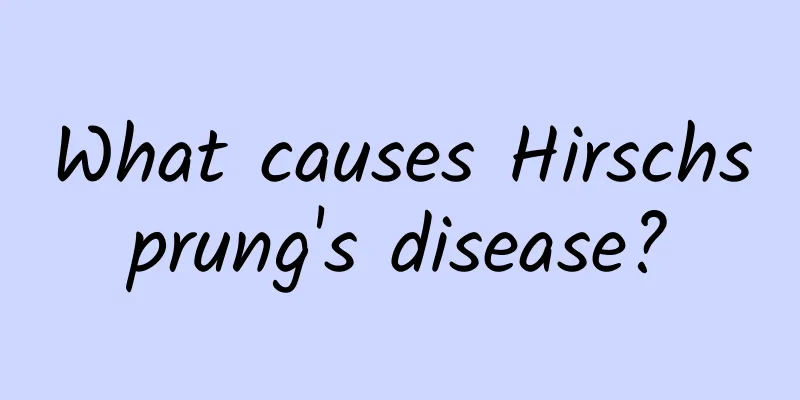What are the common symptoms of phenylketonuria?

|
The "killer" of baby intelligence - neonatal phenylketonuria is a hereditary disease. Due to the lack of phenylalanine hydroxylase in the body, the human body cannot metabolize phenylalanine. In this way, phenylalanine will accumulate in the body, causing damage to human organs, especially the brain, and seriously affecting the child's intelligence. So, what are the common manifestations of phenylketonuria? Overview Phenylketonuria, also known as PKU, is a rare genetic disorder that causes an amino acid called phenylalanine to build up in the body. PKU is caused by a defect in a gene that helps produce the enzyme needed to break down phenylalanine. Without the enzyme needed to process phenylalanine, PKU patients can experience a dangerous buildup when they eat foods containing protein or consume the artificial sweetener aspartame. This can eventually lead to serious health problems. For the rest of their lives, people with PKU—infants, children, and adults—need to follow a diet that restricts phenylalanine, an amino acid found primarily in foods containing protein. Babies in the United States and many other countries are screened for PKU soon after birth. Recognizing PKU right away can help prevent major health problems. symptom Newborns with PKU initially have no symptoms. However, without treatment, infants usually develop symptoms of PKU within a few months. Signs and symptoms of PKU can range from mild to severe and may include: A musty odor on your breath, skin, or urine caused by too much phenylalanine in your body. Neurological disorders, which may include epilepsy Skin rash (eczema) White skin and blue eyes because phenylalanine cannot be converted into melanin - the pigment responsible for hair and skin color. An abnormally small head (microcephaly) Hyperactivity Intellectual Disability Delayed development Behavioral, emotional, and social problems Mental disorders Different severity The severity of PKU depends on the type. Classic PKU. The most severe form of this disease is called classic PKU. The enzyme needed to convert phenylalanine is missing or severely reduced, resulting in high levels of phenylalanine and severe brain damage. Less severe PKU. In mild or moderate forms, the enzyme retains some function, so phenylalanine levels are not as high, leading to less risk of severe brain damage. But most children with the disease still need a special PKU diet to prevent intellectual disability and other complications. Pregnancy and PKU Women who have PKU and become pregnant face another condition, called maternal PKU. If a woman does not follow a special PKU diet before and during pregnancy, blood phenylalanine levels can rise, harming the developing fetus or causing miscarriage. Even women with milder forms of PKU may put their unborn children at risk by not following the PKU diet. Babies born to mothers with high phenylalanine levels do not usually inherit PKU. However, if a pregnant woman has high levels of phenylalanine in her blood, serious consequences can occur. Complications at birth may include: Low birth weight Delayed development Facial abnormalities Abnormally small head Heart defects and other heart problems Intellectual Disability Behavioral problems Neonatal phenylketonuria is a common chromosomal recessive genetic disease. It is mainly caused by genetic abnormalities that lead to the lack of a specific enzyme in the child's body, which makes it impossible to metabolize phenylalanine normally, causing phenylalanine and other metabolites to accumulate in the body, thereby causing a series of clinical manifestations such as mental retardation. First, children with neonatal phenylketonuria tend to have pale skin and often have symptoms of eczema. Due to the reduced synthesis of melanin, the children's hair is light, dry, and colorless. Second, the child's head circumference is relatively small and the deciduous teeth grow slowly. Third, the children's sweat and urine have unpleasant odors of rat urine and mold. Fourth, some children also show symptoms such as irritability and irritability in the early stage. Some children may have feeding difficulties, vomiting, restless sleep, and easy crying. Fifth, the symptoms of intellectual disability generally begin to become apparent 4 to 9 months after birth, especially language development disorders. Some children also suffer from epileptic seizures. Neonatal phenylketonuria patients begin to show symptoms 3 to 6 months after birth. If parents can detect it early, treat it in time, and use low-phenylalanine milk powder instead of regular infant milk powder or breast milk, they can avoid the accumulation of phenylalanine in the body and prevent brain damage. |
>>: Three major causes of Kawasaki disease
Recommend
The difference between neonatal jaundice sleepiness and normal sleep
The difference between neonatal jaundice sleepine...
What are the effective ways to prevent tics?
Many parents of young boys see other children hav...
What to do if your four-month-old baby coughs and has phlegm
If a four-month-old baby coughs and has phlegm, h...
How much does a checkup for eczema in children cost?
When our babies suffer from eczema, we mothers wi...
How to treat ADHD in children
The treatment of tics and ADHD in children is a t...
Traditional Chinese Medicine Treatment of Pneumonia in Children
There are many treatments for pneumonia. Many dis...
How to treat a child's persistent cough?
It is a common phenomenon that children have a pe...
How to treat indigestion in children How to treat indigestion in children
Indigestion in children is a digestive problem in...
How to treat myocarditis caused by cold in children
Children with myocarditis caused by a cold need t...
How to cure diarrhea in children
Pediatric diarrhea is the second most common dise...
What is Kawasaki disease and how to check it?
We should take disease prevention measures in our...
Prevention and treatment of hand, foot and mouth disease in children
Hand, foot and mouth disease is a common childhoo...
Is there a high risk of transfusion for neonatal jaundice?
Is there a high risk of transfusion for neonatal ...
What are the key points for diagnosing breast milk diarrhea?
What are the key points in diagnosing breast milk...
Sometimes I feel inexplicably sad
Sometimes we feel sad for no apparent reason. Thi...









